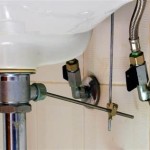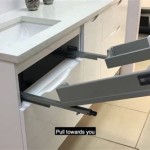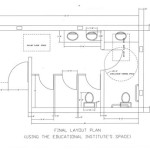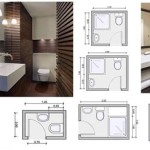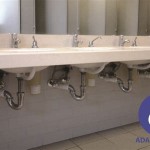What Causes A Bathroom Sink To Drain Slowly
A slow-draining bathroom sink can be a persistent nuisance. Understanding the potential causes can help homeowners troubleshoot the problem and determine the best course of action, whether it's a simple DIY fix or requires calling a plumber.
Common Culprits Behind Slow Drainage
Several factors can contribute to slow drainage in a bathroom sink. These range from simple clogs to more complex plumbing issues.
1. Hair Clogs
One of the most frequent causes of slow drainage is hair accumulation. Hair combines with soap residue and other debris to form stubborn clogs that restrict water flow. This is especially common in bathroom sinks used frequently for shaving and hair washing.
2. Soap Scum Buildup
Soap, especially bar soap, contains fats and oils that can solidify and adhere to the inside of drain pipes. Over time, this buildup restricts the diameter of the pipe, leading to slower drainage. Hard water can exacerbate this problem, as the minerals in the water contribute to soap scum formation.
3. Foreign Objects
Small objects, such as jewelry, small toys, or even toothpaste caps, can accidentally fall into the drain and obstruct water flow. While less common than hair or soap clogs, foreign objects can create significant blockages.
4. Clogged P-Trap
The P-trap is the curved section of pipe located beneath the sink. Its purpose is to trap water, creating a seal that prevents sewer gases from entering the home. However, the P-trap can also trap debris and become clogged, leading to slow drainage. Cleaning the P-trap is often a simple DIY fix.
5. Clogged Drain Pipes
Beyond the P-trap, clogs can occur further down the drain line within the branch drain pipes. These clogs can be more challenging to address and may require specialized tools like a drain snake or the assistance of a plumber.
6. Vent Blockage
Plumbing vents allow air to enter the drainage system, helping to regulate pressure and ensure smooth water flow. A blocked vent can create a vacuum effect, slowing down drainage. Vent blockages can be caused by debris, bird nests, or even ice in colder climates.
Investigating and Resolving the Issue
Addressing a slow-draining sink often begins with identifying the source of the problem. Visual inspection, using a flashlight to look into the drain opening, can sometimes reveal obvious obstructions.
Simple DIY Solutions
For simple clogs caused by hair or soap scum, several DIY methods can be effective:
*Removing Hair:
Try using a bent wire hanger or tweezers to pull out visible hair clogs from the drain opening. *Boiling Water:
Pouring boiling water down the drain can help dissolve soap scum and grease buildup. *Baking Soda and Vinegar:
A mixture of baking soda and vinegar can create a fizzing action that helps break down clogs. *Plunger:
A sink plunger can create suction to dislodge clogs in the P-trap or further down the drain line. *Cleaning the P-Trap:
Carefully placing a bucket beneath the P-trap, loosening the slip nuts, and removing the trap allows for thorough cleaning and removal of debris.When to Call a Plumber
If DIY methods prove ineffective or if the problem is recurrent, it's advisable to contact a qualified plumber. They possess the expertise and tools to diagnose and resolve more complex plumbing issues, such as deep clogs, vent blockages, or pipe damage.
Preventive Measures
Implementing preventative measures can help minimize the occurrence of slow drains:
*Hair Strainers:
Using a hair strainer or drain cover can prevent hair and other debris from entering the drain. *Regular Cleaning:
Periodically flushing the drain with boiling water or a baking soda and vinegar solution can help prevent soap scum buildup. *Avoid Pouring Grease Down the Drain:
Grease should never be poured down the drain, as it can solidify and contribute to clogs. *Proper Disposal of Foreign Objects:
Ensure that small objects are kept away from the sink area to prevent them from accidentally falling into the drain.Understanding Your Plumbing System
Familiarizing oneself with the basic components of the plumbing system, such as the P-trap and vent pipes, can empower homeowners to better understand and address drainage issues. This knowledge can also help in communicating effectively with a plumber should professional assistance be required.
Maintaining Proper Drainage
Maintaining proper drainage is essential not only for convenience but also for hygiene and preventing potential water damage. By understanding the causes of slow drains and taking appropriate preventative measures, homeowners can keep their bathroom sinks functioning optimally.

How You Can Fix A Slow Draining Drain On Your Own Call Ashton Plumbing

4 Tips To Fix A Slow Draining Sink

Slow Sink Drain 6 Diy Fixes For Before You Call A Plumber Bob Vila

How To Unclog A Slow Running Bathroom Sink Drain 10 Options

How You Can Fix A Slow Draining Drain On Your Own Call Ashton Plumbing

How Can I Clear A Slow Drain Faq Plumbing By Jake

How To Unclog A Slow Running Bathroom Sink Drain 10 Options
Why Does A Bathroom Sink Drain Slowly Quora

Slow Sink Drain 6 Diy Fixes For Before You Call A Plumber Bob Vila

Why Are The Sinks Draining Slow In My Napolis Home
Related Posts
